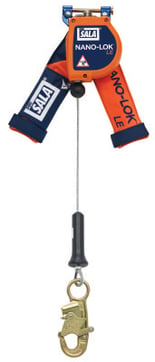Calculating Fall Distance Clearance Requirements
During a site visit, we often busy ourselves gathering information to determine if a building’s roof structure, as well as the interior beams, columns, and trusses can withstand the forces generated during fall arrest. We also collect information on fall clearance distances because fall arrest system is only as good as its ability to ensure you don’t hit the ground—or objects below the work area.
Most clients grasp structure fairly quickly, but fall clearance distance is tricky because its calculation depends on a number of variables including the type of anchor point, the PPE used to form the connection between the anchor point and the worker, and the anchor point’s location.
Anchor Point Considerations
Fall arrest anchorage takes two main forms: rigid (e.g., single point anchors, rails, tracks, and beams) and flexible, wire cable (horizontal lifelines). As the name suggests, rigid systems minimize deflection, which in turn reduces clearance distance requirements. Horizontal lifelines experience higher deflection levels during fall arrest, and as such, these systems require higher fall clearance distances. Here’s why…
When a worker tied off to a horizontal lifeline falls, energy is absorbed by the posts, which deform and / or tip over, and the length of the cable (the anchor point) increases. If we are dealing with an overhead lifeline (e.g., a gallows style system commonly used in railcar applications), use of an inline shock absorber creates a similar lengthening effect in the event of a fall. In both scenarios, this lengthening effect increases the fall clearance distance requirement.
PPE Considerations
PPE selection also influences how far you’ll drop before fall arrest—and how much fall clearance distance is needed for a given application. Shock absorbing lanyards make use of stitched up material that gives way during fall arrest. This process absorbs energy and reduces the forces exerted on the body. It also lengthens the lanyard, turning a 6 foot tethering connection into a 9 or 10 foot lanyard.
Self-Retracting Lifelines, or SRL’s, arrest falls much quicker than shock absorbing lanyards, and as such, their use decreases fall distance clearance requirements. ANSI standards require Class A SRL’s to arrest falls within 24” while Class B SRL’s must arrest the fall within 54”. Note that these are maximum values and you’ll see variances between manufacturers. That said, a lanyard will require more fall clearance distance than a Class B SRL, and a Class A retractable requires less clearance than a lanyard or a Class B SRL.
Nano-Lok Edge SRL
Anchor Point Location
Now that you understand the role that anchor types and PPE play when calculating fall clearance distance, we can turn to your next likely question: does anchor point location matter? Let’s turn now to a few hypothetical scenarios to explore anchor point location and its effect on fall distance clearance requirements.
Scenario #1—A poorly trained worker attaches a six foot lanyard to a rigid anchor point near foot level
This is a big mistake (and a violation of OSHA regulations) because OSHA 1926.502(d)(16)(iii) requires personal fall arrest systems to limit free fall to six feet or less. In this case, the worker will free fall the entire length. Getting back to clearance distances, when we include the height of the worker (6 feet) and the lengthening of the lanyard (10 feet), combined with a safety factor (3 feet), our number is 18-1/2 to 19 feet. The question is this—does our hypothetical worker have this kind of real estate available before he comes into contact with some type of structure below—or the ground? It’s important to remember our anchor point had minimal deflection in this scenario. If the worker is tied off using a horizontal lifeline, the fall distance requirements increase. In case you are curious why we NEVER recommend use of a lanyard at foot level, now you know why.
Scenario #2 –A Worker Attached to a Rigid Anchor Point Using A SRL
One of the obvious advantages to using a retractable is that we don’t need to factor in the entire height of the worker when calculating our fall clearance distance. Here, the calculation is 24” for Class A or 54” for a Class B retractable plus your safety factor of three feet—and these numbers are good regardless of how high the anchor point is positioned above the D-ring.
And although or starting premise in this scenario is a rigid anchor point combined with a SRL, you could switch gears and suppose use of a horizontal lifeline, and anchor point location still is not a factor. You’ll add to the clearance requirements due to deflection of the cable, but the calculation will still come in far short of that required when using a lanyard.
If you are still reading this post, we hope the light bulb is turning on. Anchor type and PPE selection are more important considerations than where the anchor is placed. You might think that placing the anchor high overhead would yield a greater margin of safety, but this isn’t the case.
To make a definitive calculation, you’ll need to consider how the PPE from a given manufacturer interacts with a particular system type, the weight of the worker, and how many workers are attached to the fall arrest system. The number of workers falling may also factor into the calculations. This is why it is so important to work with a fall protection company with the engineering resources needed to make these types of calculations. If you originally Googled the phrase “How to calculate fall clearance distance” in the hopes that you might fashion your own homemade fall protection solution, we hope the material discussed in this post encourages you to think again.
To learn more about fall protection, or to discuss a specific application, contact the fall protection safety specialists at Diversified Fall protection for further assistance.
Schedule an assessment with Diversified Fall Protection
Contact Us to request a fall safety review

b-1.jpg?width=1368&height=1340&name=Rail%20(175)b-1.jpg)

